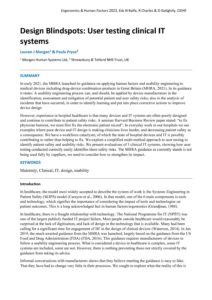| Document | Author Lauren J Morgan & Paula Pryce |
| Abstract In early 2021, the MHRA launched its guidance on applying human factors and usability engineering to medical devices including drug-device combination products in Great Britain (MHRA, 2021). In its guidance it states: A usability engineering process can, and should, be applied by device manufacturers in the identification, assessment and mitigation of potential patient and user safety risks; also in the analysis of incidents that have occurred, in order to identify learning and put into place corrective actions to improve device design However, experience in hospital healthcare is that many devices and IT systems are often poorly designed and continue to contribute to patient safety risks. A seminar Harvard Business Review paper stated: “to fix physician burnout, we must first fix the electronic patient record”. In everyday work in our hospitals we see examples where poor device and IT design is making clinicians lives harder, and decreasing patient safety as a consequence. We have a workforce cataclysm, of which the state of hospital devices and IT is possibly contributing to rather than helping to fix. We explore a simplified multi-method approach to user testing to identify patient safety and usability risks. We present evaluations of 3 clinical IT systems, showing how user testing conducted correctly easily identifies these safety risks. The MHRA guidance as currently stands is not being used fully by suppliers, we need to consider how to strengthen its impact. |

